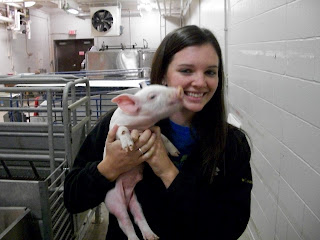This semester I am in a swine production class and we have recently had some interaction with some sows, female pigs. We currently have six sows on campus. They just got done farrowing, or giving birth, this week. I got to see one of the sows farrow on Sunday and I got to give an older of pigs iron shots, clip tails, notch ears and castrate the males. I had heard about these procedures before but this time I actually got to help.
 |
| Piglets pile under the heat lamp |
When sows farrow they are put in farrowing stalls. Farrowing stalls are 5x7 feet where the sow is positioned in the center so when she has her piglets they can get away from her so they are not squished when she lays down. Piglets that are raised indoors require a supplemental iron shot in the first three days of their life. These shots are given behind the pigs’ ear. Piglets also have their tails clipped to prevent other pigs from chewing on them later in their life. Most hog producers also notch ears for identification. Notches on certain parts of the ear stand for different numbers. The pigs’ right ear identifies which litter the pig came from, the left ear indicates the individual pigs’ number. This means if two pigs have the same notches on their right ears they can possibly be littermates. And like with most meat animals, the boars, male piglets, are castrated and then referred to as barrows.
 |
| Piglets relaxing after processing |
To some people, these common procedures may seem hard on the piglet or inhumane, however I saw it first-hand. Because piglets are born in litters of 8-12 piglets they are only around three pounds at birth. Most piglets squeal when you pick them up and therefore continue to squeal during processing. As I watched other students process their piglets I noticed that the piglets did not seem to change their reaction when having their tails docked, ears notched, etc. When the piglets were put back in the farrowing stall they stopped squealing and went almost directly back to normal activity (nursing, walking around, or laying under heat lamps). Some might also think that there would be a difference in behavior after processing between the barrows and the gilts, females that have not farrowed. The males were not sedated and no sutures were involved but they reacted the same way the gilts did. I specifically looked for differences and found none. Hog producers could use anesthetics and sutures but after seeing how the pigs react I believe they do the right thing because the pigs just want to be back in their pen, not held for a longer period of time. The pigs are so little that they are not really affected by processing and are back to normal in a very short period of time.
 |
| Myself with a piglet |
I have learned a lot from taking care of the sows and piglets this week. It is a lot easier to understand why hog producers do what they do when you watch it yourself. Hog producers know best because they are experienced and care about their animals.

No comments:
Post a Comment